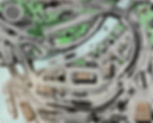Artwork or Game Plan? Evaluating Published Track Plans.
- lmindheim
- Feb 24, 2022
- 3 min read
Updated: Feb 7, 2023

Just because a track plan illustration is pleasing to look at from an artistic standpoint doesn't mean that it's a viable design. Read on...
When you look at a published track plan in a periodical, are you drawn in by its artistic qualities or the viability of the design? Without question there are some gifted illustrators working for the hobby press. They can take any back-of-a-napkin track plan sketch and transform it into a veritable Rembrandt. It’s easy to be so captivated by the artistic aspects of an illustration that you overlook whether or not it’s actually a viable design. Some are not.
Ours is a hobby of participation and designs are simply guides or roadmaps to creating something in three dimensions. They aren’t meant to be framed and hung on the living room wall. If you see a published plan that appeals to you, here are some things to check to help you determine if it’s actually buildable and will be comfortable to interact with.
Turnouts. Turnouts, and their transitions, take up a lot of space. In an effort to make things fit, some published plans use excessively sharp turnouts such as number threes. They may also employ turnout transition geometry that would result in unreliable operation. Number six turnouts are a “safe” standard. The need to use anything sharper is at least a yellow flag that there is some overreaching going on with the design and possibly a case of trying to do too much. When the number three turnouts on an artful illustration are replaced with number six switches, designs quickly unravel.
Reach in Distances. Murphy’s law of model railroading means that if you have a derailment or stalled locomotive it will occur on the stretch of track that is the most difficult to reach. Track needs to be cleaned, repaired, and tuned occasionally. Sometimes your equipment will malfunction or derail. A well designed plan has track that is easily reached at all locations. This means no rail further than 24 inches from the fascia. Reach in distance applies to scenery construction also. It’s hard to do good work in areas you can’t reach and working from a step stool gets old quickly. No scenery point on the layout should be more than 30 inches from the fascia.
Grades. Yards and industrial spurs need to be flat. Is that the case with the plan you’re looking at or, are some of them on slopes? Having turnouts near the start or end of a grade can cause operational problems. Grades over two per cent become significant. Longer trains and some locomotives might not be able to handle them.
Hidden Track. The only thing worse than visible track that is hard to reach is hidden track. Hidden track gets old quickly and in most cases isn’t a design feature that makes for comfortable interaction. I would consider it a poor design feature.
Duck Unders. One duck under to enter the layout room can pay large enough dividends that the inconvenience is probably worth it. Having more than one duck under is not a good sign.
Bridge Clearance. If you have one track passing over another, is there enough clearance for the rolling stock without resorting to excessively steep grades?
Can You Follow the Trains? As you walk beside the fascia, following your train in its journey, can you stay next to it the entire route without being cut off? Or, are you cut off by a peninsula and need to sprint around it to catch up to your train?
Multiple Decks. Unless you are a dyed-in-the-wool operator where maximizing run length is paramount, there is no compelling reason to go to multiple decks. There are just too many ergonomic compromises to be worth it and constructing them can get complex quickly.
Switchbacks. While switchbacks are occasionally used on the prototype, they are relatively rare and a hassle to switch. If the plan you’re looking at has more than one it can be a warning sign.
Aisles Widths. It’s okay to have some narrow pinch points in the aisles as long as they aren’t too long. Having narrow aisles throughout the layout will get old very quickly.
Lifestyle Fit. Does the plan take into account your skill level and available hobby time? Can you get it up and running relatively quickly without frustration?
Finally, look at the plan in context. Is it part of an article about a layout that was actually built? Or, is it just an intellectual exercise?
Evaluating a plan by its technical and operational characteristics, as opposed to the artistry of the illustration, can save you a lot of frustration down the road.


